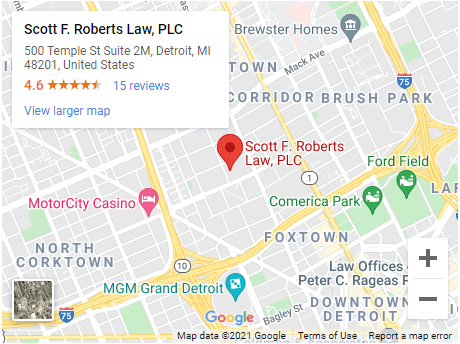By: Scott Roberts and Louis Magidson
The Cannabis Regulatory Agency of Michigan (CRA), formerly the Marijuana Regulatory Agency (MRA), is virtually the same agency post name-change. In an effort to recognize the proper scientific name of the product it monitors, the Cannabis Regulatory Agency has released a new set of Best Practices for all CRA stakeholders. These new practices will add to the prior regulations updates released by the MRA last year. The new Best Practices release follows on the heels of the rebrand from MRA to CRA –the new set touches on nearly every aspect of how to stay compliant in the cannabis industry of Michigan.
Destruction
The CRA details the proper destruction-of-products methods for
noncompliant & unmarketable products. To properly dispose of unusable products, documentation of the destruction must be recorded, including the full Michigan Enforcement Tracking Reporting & Compliance (METRC) tag number, the reason for destruction, and photo/video evidence of the actual destruction of the product required to be kept on a waste/destruction log. After destruction, the package(s) must be properly reduced to 0 on METRC and entered as “waste” for the reason code along with the date of destruction.
Even though documentation is not required to be sent to the CRA, all of the above materials must be available to the Agency upon request. Any product placed on administrative hold must obtain CRA approval before destruction, as the product(s) may be needed for further investigation. The following is a CRA checklist for creating the photo/video evidence of a destroyed product.
- PHOTO/VIDEO EVIDENCE: The CRA must be able to identify the destroyed product and the actions taken by the licensee within the photo/video evidence.
- Make sure the destruction is taking place with a clear camera view
- The frame should be free of obstructions
- All staff destroying product should be behind the product to not obstruct the view
- The product should be shown in its storage container before any product is removed.
- The METRC tag number should be visible (if possible, hold it up to the camera).
- The weight or count should be shown prior to destruction, either by weighing the product
or by placing the individual items in groups (i.e., 10, 20, etc.) to clearly demonstrate the number of products on hand that are being destroyed.
Transfers
Any transfers of cannabis products must be traceable in the METRC system. To properly transfer marijuana products from one licensed business to another, the product must have an up-to-date package/transfer tag. This tag will be assigned to a finished product and must be consistent throughout its transfer to the correct finished product. For plant products and intermediate products (which are used to finished product), the original source package tag is not required to be retained, because a new package/transfer tag will be issued for the final finished product.
Labeling Requirement Variations
Cannabis business-to-business transactions vary depending on the
CULTIVATOR-TO-CULTIVATOR
Requirements for transfer tags:
- Business or trade name
- License number
- Package/transfer tag assigned by METRC
- Name of the strain
- Date of harvest
- Seed strain
- Universal symbol
PRODUCER-TO-PRODUCER
Requirements for transfer tags:
- Business or trade name
- License number
- Package/transfer tag assigned by METRC
- Universal symbol
CULTIVATOR/PRODUCER-to-SALES LOCATION
(Requirements are more complex as they are being directly marketed and sold to consumers.)
- Business or trade name
- License number
- Package/transfer tag assigned by METRC
- Business or trade name & Marijuana license number of packager of the product (if different from the product of the product)
- Date of harvest (if applicable)
- Name of strain (if applicable)
- Net weight (US or Metric)
- THC and CBD concentrations (within 10% accuracy from licensed potency-testing lab)
- Activation Time of the product (in writing or with a picture)
- Name of the licensed compliance lab that tested the finished product
- Universal symbol for marijuana products published by the CRA
- A warning that MUST include all the following statements on any final cannabis product
- “It is illegal to drive a motor vehicle while under the influence of marihuana.
- “National Poison Control Center 1-800-222-1222.”
- For products being sold by a marihuana facility that exceed the maximum THC levels allowed for products sold under MRTMA: “For use by registered qualifying patients only. Keep out of reach of children.”
- For all other products: “For use by individuals 21 years of age or older or registered qualifying patients only. Keep out of reach of children.”
- In clearly legible type and surrounded by a continuous heavy line:
“WARNING: USE BY PREGNANT OR BREASTFEEDING WOMEN, OR BY WOMEN PLANNING TO BECOME PREGNANT, MAY RESULT IN FETAL INJURY, PRETERM BIRTH, LOW BIRTH WEIGHT, OR DEVELOPMENTAL PROBLEMS FOR THE CHILD.”
Product Categories – Production Batch Changes
Cannabusiness people know very well that the final forms of many marijuana products are not derived directly from cannabis flower. Many products are created from cannabis concentrate, known as production batches. These production batches must be assigned new package tags for complaint usage to make new products like vaporizer cartridges or infused edibles. Those finished products must be given a new final package tag to make it compliant.
Weight is Key
The main takeaway from this practice is to confirm that the weights of the products are marked on the package tags at every stage. This provides transparent data to the CRA on what and how much of the product is being used in both the production batches and the finished products.
Samples
A large area of concern for the CRA comes from the concept of product samples. Obviously, samples are a great way to attract and retain customers (both individuals and licensed cannabis businesses who want to sell your products). Compliant samples avoid some of the more stringent requirements described above for regular cannabis product transfers. The CRA monitors when, where, how, and to whom samples are provided to offer this relaxed treatment.
Trade Samples
Trade samples are samples that a cultivator or processor/producer may send to a cannabis retail location to market the product and secure purchase orders. These types of samples do NOT need to use a licensed secure transporter if the sample size does NOT exceed 15 ounces of cannabis flower or 60 grams of cannabis concentrate.
Samples must still be entered into METRC as a “sample”, of course, but the sample must be adjusted in METRC to account for how much “sample” is being distributed out of the source package by quantity. The adjustment reason is marked as “trade sample,” and must include the license number for the receiving cannabis business and the quantity of product being distributed.
A producer or cannabis sales location receiving a trade sample may distribute the trade sample to its employees to determine whether to purchase the cannabis product. A producer or cannabis sales location is limited to transferring a total of 1 ounce of cannabis, a total of 6 grams of cannabis concentrate and cannabis-infused products, with a total THC content of 2000 mgs, of internal product samples to each of its employees in a 30-day period.
All licensed cannabis businesses providing samples to either other cannabis businesses or to employees of their business must keep up-to-date internal records of all allotted samples. Keeping accurate records of samples provided will eliminate the potential compliance issues many businesses experience with over-providing samples and risking their license in the process.
Internal Product Samples
Internal Product Samples require have even oversight for compliant transfers. These sample transfers to employees may be performed by cultivator, producer, marijuana sales location, marijuana microbusiness, or Class A marijuana microbusiness. These types of sample batches may NOT be transferred or sold to another licensee or consumer. All internal samples DO need to be entered into METRC as internal samples to remain compliant. To record internal product samples in METRC, adjust the source package down to account for the product being distributed. The adjustment reason is marked as “internal product testing samples.”
Each employee’s name, METRC ID, and quantity of product received will need to be included in the note for the adjustment reason. All cannabis businesses are required to keep internal records of how much product was provided to each employee.
METRC Transfer Codes and When to Use Them
- ADULT-USE AFFILIATED TRANSFER
- For transfers between adult-use licenses with same ownership
- ADULT-USE SEEDS AND SEEDLINGS
- For adult-use cultivators to bring in seeds or seedlings from individuals aged 21 or older
- CAREGIVER
- For medical cultivators to bring in seeds, seedlings, tissue cultures, or cuttings from a registered caregiver
- EDUCATIONAL RESEARCH LICENSE TRANSFER
- For transfers to an Educational Research License
- EXTERNAL CANNABINOIDS
- For acquiring hemp-sourced cannabinoids from businesses that do not hold a marijuana license
- GROW TO GROW BETWEEN MEDICAL AND ADULT-USE
- For equivalent license transfers between cultivators
- HEMP CBD R&D CONVERSION TRANSFER
- For bringing hemp-sourced CBD from a business that does not hold a marijuana license for the purposes of R&D
- IMMATURE PLANTS BETWEEN MEDICAL AND ADULT-USE
- For transferring immature plants between equivalent medical & adult-use licenses under same ownership
- INFUSION TRANSFER
- For transferring plant material for extraction when an upfront price has not been negotiated
- MEDICAL AFFILIATED TRANSFER
- For transfers between medical licenses with same ownership
- MICROBUSINESS TRANSFER
- For allowable transfers of seeds, tissue cultures, and clones (which do not meet the definition of a plant) to a microbusiness.
- PROVISIONING CENTER AND RETAILER BETWEEN MEDICAL AND ADULT-USE
- For equivalent license transfers between sales locations
- PROCESSOR TO PROCESSOR BETWEEN MEDICAL AND ADULT-USE
- For equivalent license transfers between producers
- TEMPORARY EVENT
- To create a manifest for product going to a temporary event.
- This transfer must be voided after the manifest is printed.
- TEMPORARY EVENT – RETURN
- To create a manifest for product returning from a temporary event.
- This transfer must be voided after the manifest is printed.
- TESTING TRANSFER (to Safety Compliance Facilities)
- For transfers to Safety Compliance Facilities (SCF) where the SCF is the transporter
- TRADE SAMPLE TRANSFER
- For trade sample transfers to another license where the shipping facility is the transporter (if carrying more than 15 ounces of marijuana or 60 grams of concentrate, a secure transporter is required)
- WHOLESALE
- For transfers between licenses when the product is being sold with an upfront price negotiated.
- Prices should not be listed as rates-per-pound and should be the price paid for the product.
Shipping Errors
All errors made during shipping and receiving must be corrected. Physical and electronic inventory must match exactly to be compliant. Examples of common errors include:
- receiving more or less than what is stated on the manifest
- receiving product not on a manifest
It is NEVER acceptable to correct the errors by adjusting the packages.
All errors should be reported to METRC support for assistance with correcting them compliantly. The CRA will not approve virtual manifests directly to licensees. If the only correction for the error is to amend a virtual manifest, METRC support will reach out to the CRA for approval.
Facility Inventory Errors
All inventory errors must be corrected. Physical and electronic inventory must match exactly to be compliant. Examples of common errors include:
- Not creating products as production batches
- Adjusting down package sizes instead of creating a new package
- Packaging errors during the harvest process.
All errors should be reported to METRC support for assistance with correcting them compliantly.
Navigating these issues can be overwhelming for most small-medium business owners. For this reason, it is recommended that any entity looking to enter or expand their operations in the cannabis business compliantly should contact the experienced cannabis law attorneys at Scott Roberts Law today.




